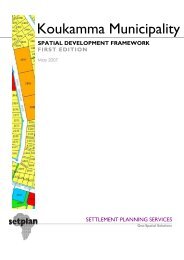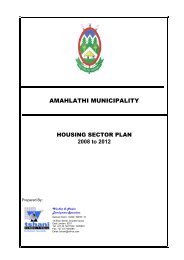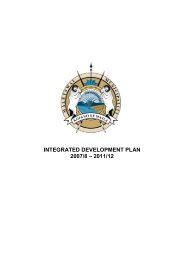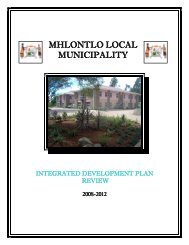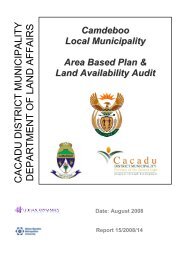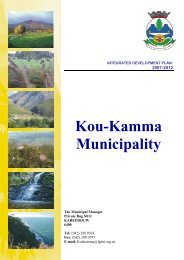intsika yethu local municipality - Provincial Spatial Development plan
intsika yethu local municipality - Provincial Spatial Development plan
intsika yethu local municipality - Provincial Spatial Development plan
You also want an ePaper? Increase the reach of your titles
YUMPU automatically turns print PDFs into web optimized ePapers that Google loves.
Chapter 3: <strong>Development</strong> Priorities, Strategic Objectives,Strategies and Projects6. Vision, Mission, and Key Performance AreasThis chapter of the IDP provides an overview of the strategic intentions of IYLM and presents prioritisedissues which the <strong>municipality</strong> seeks to address over the medium term. This section thereforesystematically prioritizes all the issues that have surfaced from the situational analysis and communityconsultations and presents what the organisation seeks to achieve in relation to these issues over the nextfive years.Although <strong>local</strong> government is the sphere closest to communities at the heart of government’s developmentagenda, the Constitution requires that governance at the <strong>local</strong> level be subject to national and provinciallegislation. Section 25 (1) (e) of the Municipal Systems Acts clearly states that an IDP adopted by aMunicipal Council must be compatible with national and provincial development <strong>plan</strong>s and <strong>plan</strong>ningrequirements binding on the <strong>municipality</strong> in terms of legislation. The synergy, alignment and coordinationbetween the various development <strong>plan</strong>s and strategic imperatives of the three spheres of government (i.e.IDP, PGDP, NSDP, National Outcomes Approach, etc) is vital in order to achieve proper coordination andalignment of development initiatives within the region and <strong>local</strong>ity.In order to ensure that <strong>local</strong> government interventions drive the desired socio-economic changes in linewith government’s development agenda, integrated <strong>plan</strong>ning, monitoring and reporting of municipalinitiatives is crucial. Government’s emphasis upon an outcomes orientation for all interventions, inclusiveof projects implemented by Sector Departments, necessitates that strategic considerations regarding theallocation of scarce resources are made to best address prioritised issues. This section contributes towardsa shared understanding of the priority issues of communities, and how this has informed the broaderstrategic developmental trajectory of the <strong>municipality</strong>, ultimately in pursuit of better coordination,alignment of programmes and improved impact on the ground.As the Council elected in May 2011 has sought to ensure direction and guidance in driving <strong>local</strong>development, it has produced a renewed Vision, Mission, and Values for the IYLM. But in order to ensurethese strategic intentions translate into the achievement of outcomes on the ground for citizens, it needs tobe clear how Council’s political directions cascade through a clear organisational logic towards therealisation of IYLM’s constitutional mandate of developmental <strong>local</strong> government.The figure below provides a visual representation of the logic that informs how the strategic direction ofIYLM, as formulated by Council, finds expression from the Vision statement of the <strong>municipality</strong>, down tothe Projects on the ground. The apex strategic statement is that of the Vision of IYLM, derived from theshared Values of its people and political leadership, and articulating a future in which the Priority Issueshave been sufficiently addressed. Institutional purpose in relation to the stated Vision is expressedthrough the organisation’s Mission, articulating what shall be done towards the realisation of that desiredfuture. This Mission is then supported by a set of Goals, roughly aligned to the Key Performance Areas of<strong>local</strong> government. These Goals are unpacked and expressed at a lower level as Strategic Objectivestatements, identifying the intended benefits of IYLM’s course of action over the medium term, asinformed by the Priority Issues identified by communities, staff, Council, and through compilation of theSituational Analysis. These Priority Issues emanate from the ground up, and are addressed through alllevels of the organisation’s strategic intentions, although most directly at the Strategic Objectives level.How the Strategic Objectives are realised is thereby dependent upon the Strategies employed by the88







